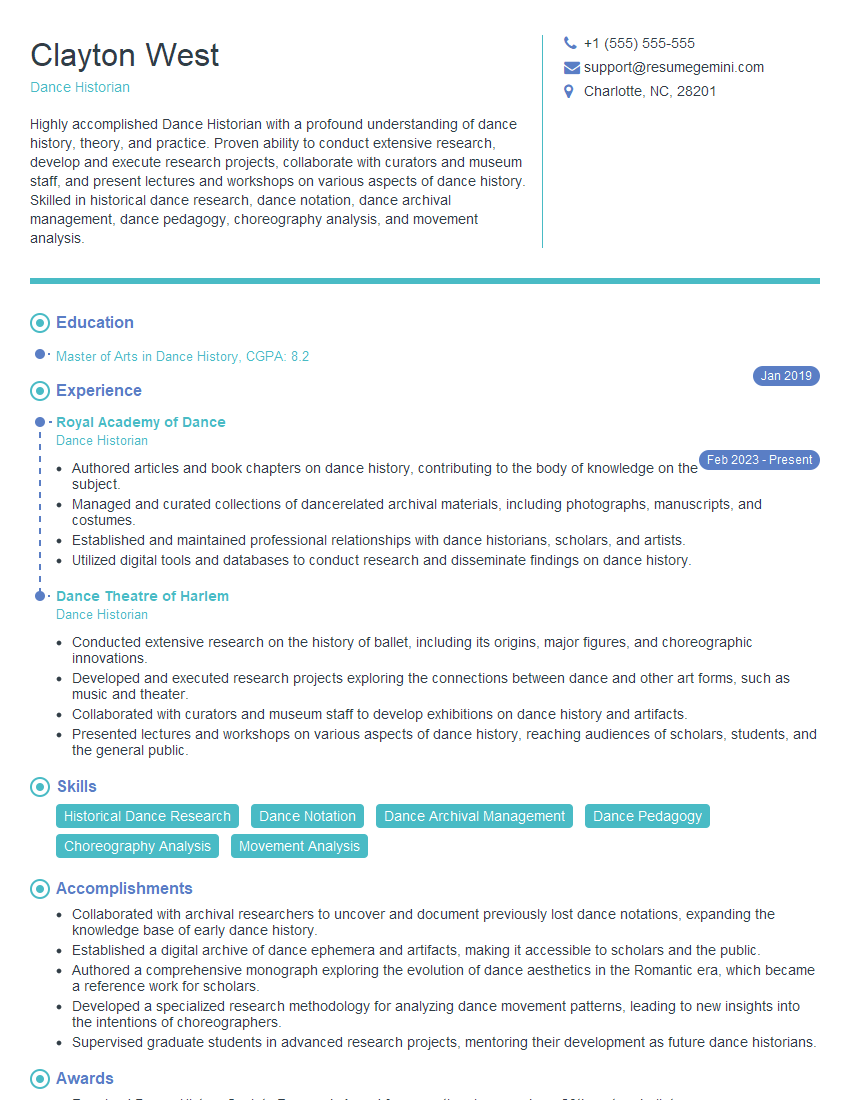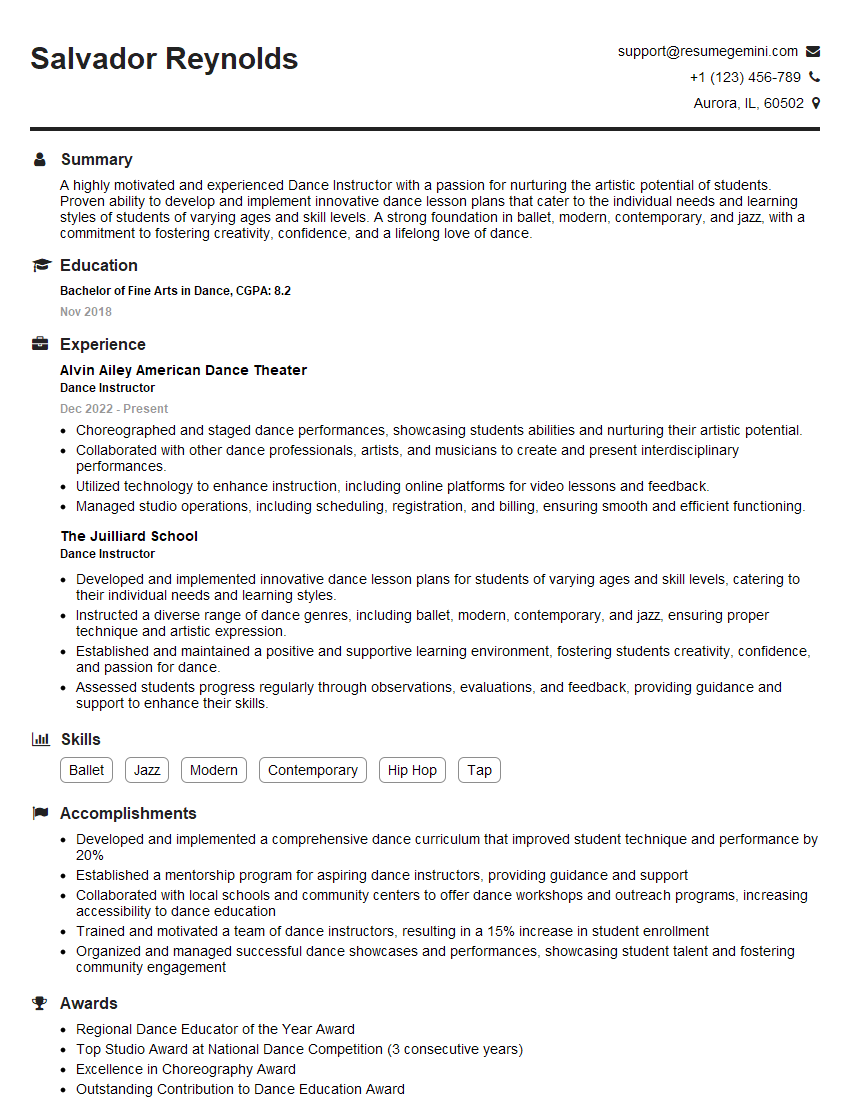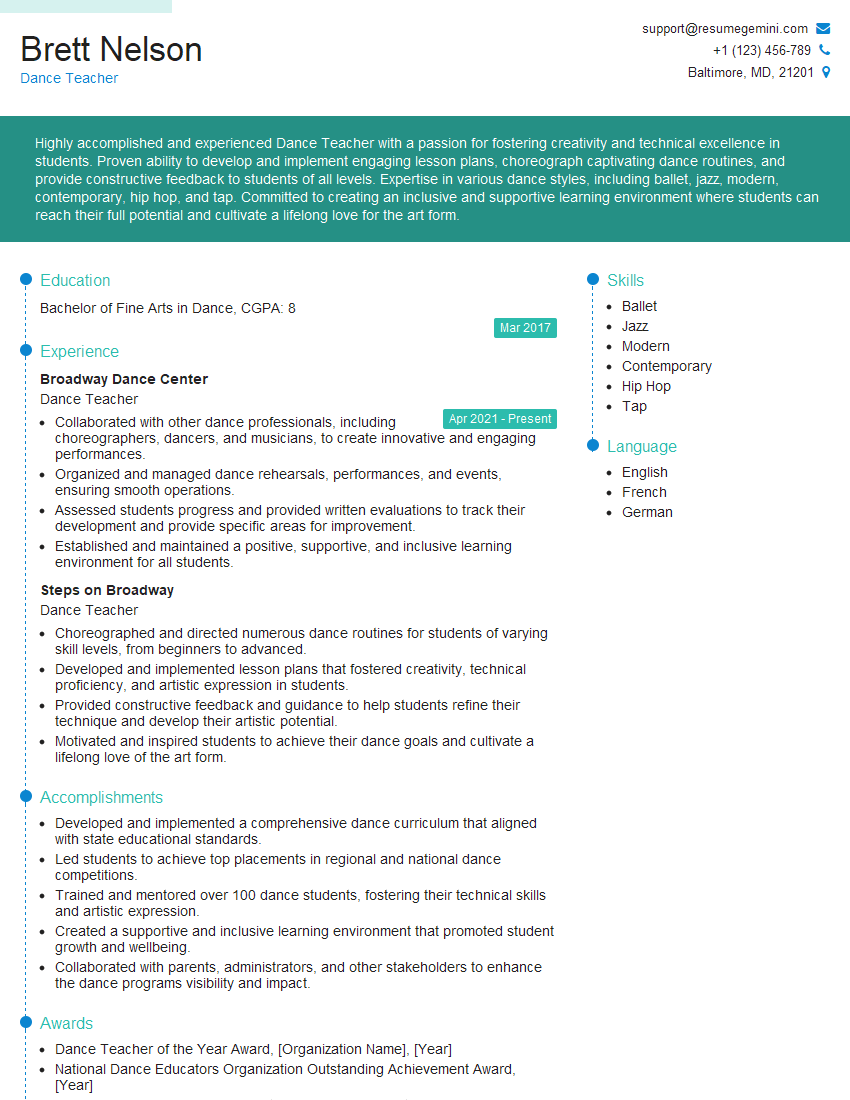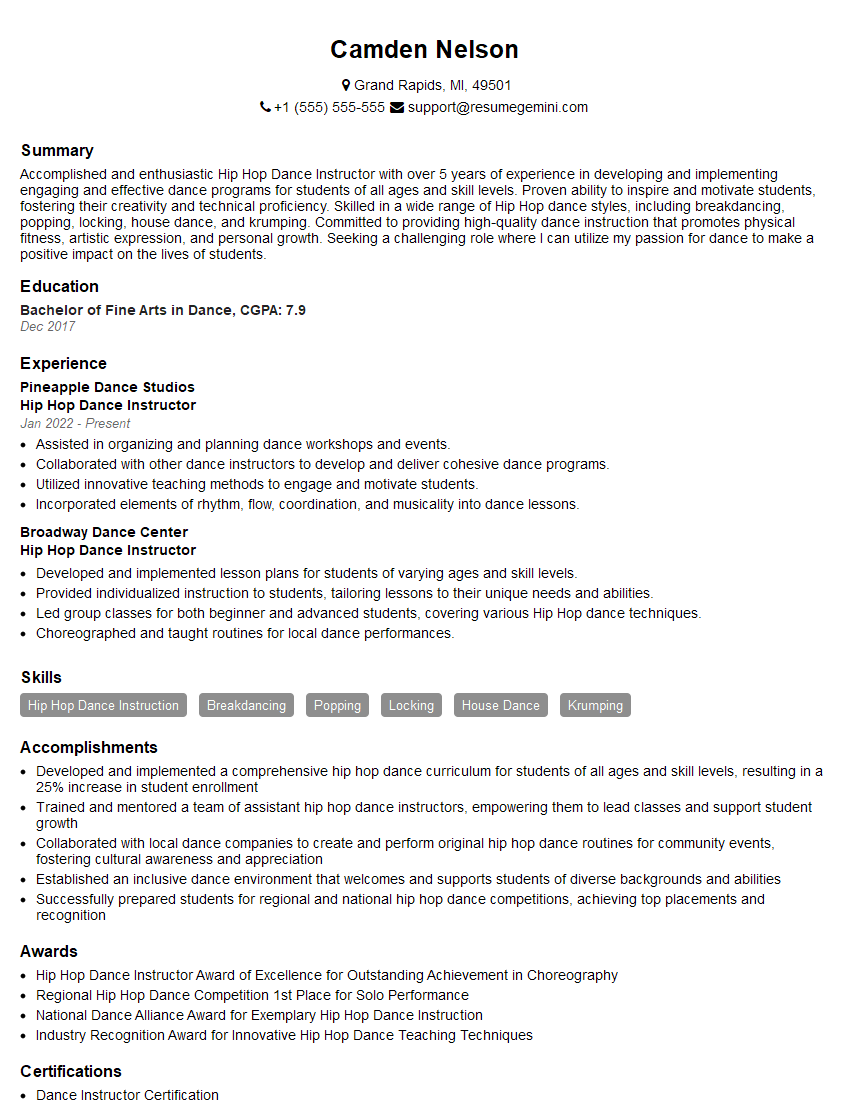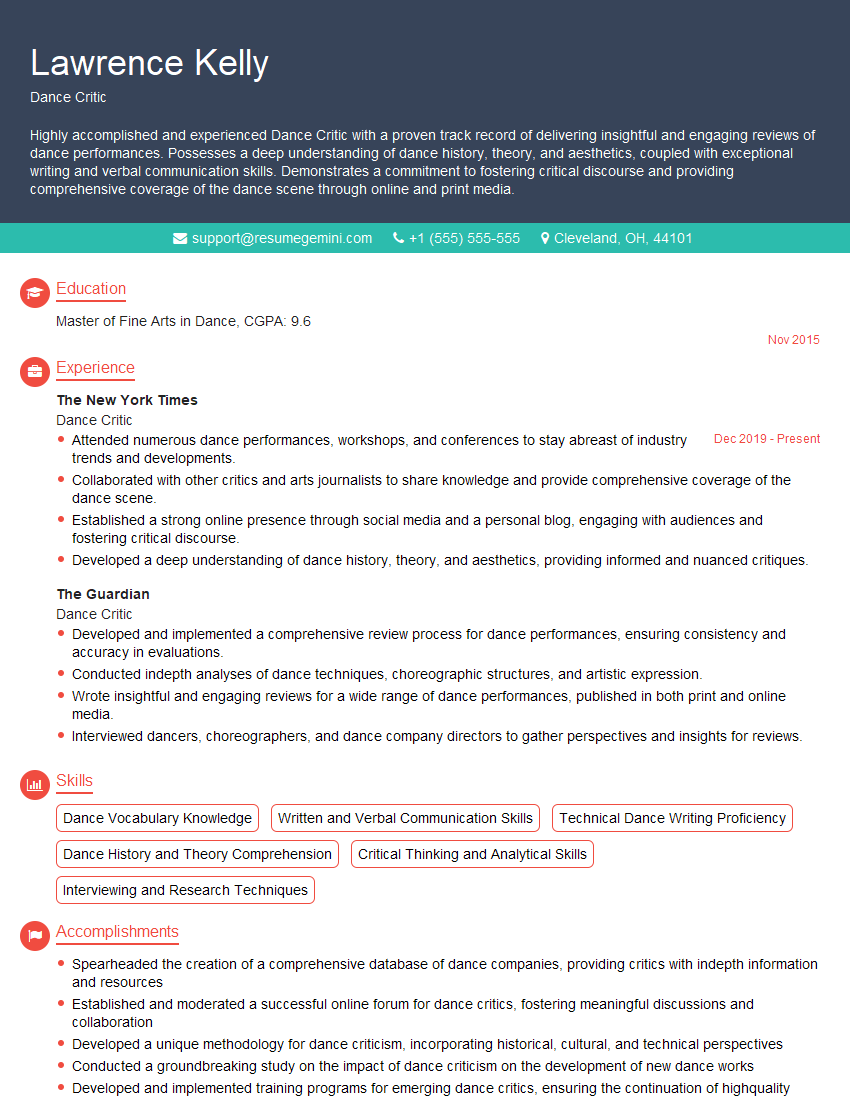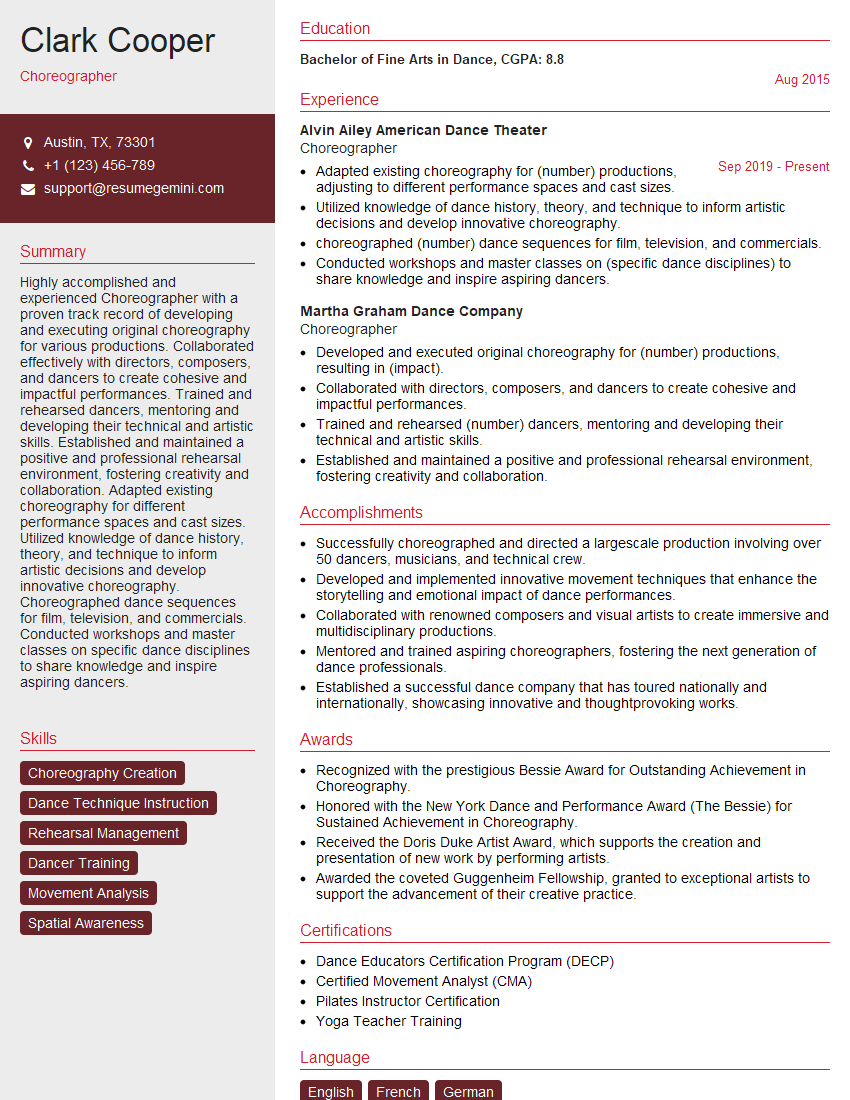Unlock your full potential by mastering the most common Knowledge of Different Dance Styles and Forms interview questions. This blog offers a deep dive into the critical topics, ensuring you’re not only prepared to answer but to excel. With these insights, you’ll approach your interview with clarity and confidence.
Questions Asked in Knowledge of Different Dance Styles and Forms Interview
Q 1. Describe the key differences between ballet and modern dance techniques.
Ballet and modern dance, while both expressive art forms, differ significantly in their techniques and philosophies. Ballet, a highly codified style, emphasizes precise, outwardly controlled movements, often executed on pointe (for women). It prioritizes turnout (rotation of the legs from the hips), elegant lines, and a structured vocabulary of steps and positions. Think of the graceful arabesques and perfectly aligned pliés. Modern dance, in contrast, is far more fluid and improvisational. It often rejects the rigid structure of ballet, embracing floor work, contractions, and release techniques to express emotion and explore movement possibilities. Modern dancers often use their own weight and gravity more directly, resulting in movements that appear more grounded and visceral. Consider the stark contrast between the soaring lifts of a classical ballet and the grounded, emotive floor work common in modern dance.
- Ballet: Emphasis on precise technique, turnout, elegant lines, pointe work (for women), structured vocabulary.
- Modern: Emphasis on expression, improvisation, floor work, contractions and releases, less emphasis on strict technique.
Q 2. Explain the basic steps of a waltz.
The waltz is a three-beat dance, with a strong emphasis on the first beat. Imagine a slow rocking motion. The basic steps are as follows:
- Step 1: Begin with your feet together. The man usually leads with his left foot, and the woman follows with her right foot, stepping to the side.
- Step 2: Step to the side with your other foot (right foot for the man, left foot for the woman), closing your feet slightly.
- Step 3: Bring your feet together, shifting your weight to the foot that’s now leading. This completes one measure, and you repeat the sequence. During the steps you should maintain a comfortable distance and sway your body gently to follow the rhythm of the music.
It’s important to maintain a smooth, flowing movement between each step, keeping your body weight balanced and relaxed. Partners sway and turn together creating a beautiful flowing pattern. The basic waltz step can then be expanded to incorporate turns, dips, and other more advanced movements.
Q 3. What are the fundamental principles of choreography?
Choreography is the art of creating dance sequences. Fundamental principles include:
- Theme and Concept: Every piece needs a central idea or narrative to guide the movements.
- Movement Vocabulary: Selecting appropriate steps and phrases relevant to the style and the story.
- Structure and Form: Organizing the dance into a coherent sequence (e.g., introduction, development, climax, conclusion). Think of it like writing an essay for dance.
- Space and Dynamics: Utilizing the stage effectively, varying levels (high, medium, low), and incorporating changes in speed, energy, and rhythm (dynamics) to create interest.
- Musicality and Rhythm: Matching movement to the music and feeling its pulse.
- Artistic Expression and Intention: The choreographer’s vision and how they communicate it through movement to the audience.
A choreographer will carefully consider these factors, often spending months or even years perfecting a dance piece. They may start with improvisation, exploring various movements, and gradually refine and shape them into a cohesive whole.
Q 4. Compare and contrast the rhythmic structures of Salsa and Tango.
Salsa and Tango, both Latin dances, have distinct rhythmic structures:
- Salsa: Typically uses a
4/4time signature with a strong emphasis on the first and third beats. It’s a highly syncopated dance featuring quick, rhythmic footwork and complex patterns. Often described as having a lively and energetic feel. - Tango: Primarily uses a
2/4or4/4time signature depending on the style but generally features a slower, more deliberate tempo. It’s characterized by its dramatic pauses, close embrace, and sharp, angular movements. It’s often described as sensual and passionate.
While both styles use rhythmic complexity, Salsa’s rhythm is more upbeat and syncopated, whereas the Tango’s is more measured and punctuated by pauses that add to its dramatic intensity.
Q 5. How would you teach a beginner the basic steps of hip-hop?
Teaching a beginner hip-hop involves breaking down fundamental movements into easily digestible parts. I’d start with:
- Basic Footwork: Introducing the two basic steps: stepping and rocking. Stepping would involve simple steps in various directions. Rocking would involve shifting your weight gently from one foot to the other in a rhythmic pattern. Practice each step slowly to develop a strong sense of rhythm.
- Simple Arm Movements: Introducing basic arm movements like punches and waves. Show how to coordinate the arm movement with the footwork.
- Putting it Together: Combine these basic movements to create short, simple sequences, like stepping to the left with a punch and then stepping to the right with a wave. Emphasize fluidity and groove.
- Body Control: Focus on posture, balance, and isolation. Isolation involves moving one body part (e.g., the head or chest) independently of the rest of the body. It is crucial for adding flavour and complexity.
- Music Selection: Choose upbeat hip-hop songs with clear beats.
Throughout the process, it is important to maintain an enjoyable, encouraging environment, and reinforce the basic rhythmic concept. Regular practice and exposure will help beginners build confidence and proficiency.
Q 6. Discuss the importance of musicality in dance performance.
Musicality is paramount in dance performance; it’s the very essence that brings the movement to life. A dancer’s ability to interpret and translate music into physical expression is key. It encompasses several aspects:
- Rhythm: Matching the tempo, pulse, and accents of the music with precise movement. This involves feeling the beat and subtly emphasizing the strong beats.
- Dynamics: Responding to changes in volume, intensity, and mood of the music with corresponding shifts in energy level, speed, and expression.
- Phrasing: Organizing movement into meaningful phrases, mirroring the musical phrasing and structure.
- Emotional Interpretation: Understanding and conveying the emotion inherent in the music through body language and movement quality.
Imagine a dancer performing a lyrical piece to a melancholic melody; their movements would reflect that sadness, perhaps through slow, flowing gestures and downcast eyes. Conversely, a high-energy piece would warrant sharp, powerful, dynamic movements. Lack of musicality can make a performance feel disjointed, lacking heart, and ultimately, less impactful.
Q 7. Explain the role of improvisation in contemporary dance.
Improvisation plays a vital role in contemporary dance, allowing dancers to explore movement spontaneously, pushing creative boundaries, and fostering self-expression. It allows for a more direct connection between the dancer’s body and their internal emotions.
- Spontaneity and Creativity: It encourages dancers to move freely and develop unique movement vocabularies.
- Exploration and Discovery: Improvisation provides a space for self-discovery, pushing dancers beyond their technical limits and encouraging creative problem-solving.
- Authentic Expression: Improvisation can unlock authentic expression as dancers respond naturally to the music or a given stimulus.
- Collaboration and Interaction: Improvisational techniques often form the foundation of ensemble pieces, fostering dialogue and creative exchange among dancers.
A choreographer might utilize improvisation during the creation process, guiding dancers through movement exercises that encourage exploration and allow for unexpected discoveries. This creates unique choreography that retains a sense of freshness and authenticity. Even in highly structured contemporary works, moments of improvisation can be injected to maintain energy and dynamism.
Q 8. What are some common injuries in dance and how can they be prevented?
Dance, while beautiful, puts significant stress on the body, leading to various injuries. Common ones include ankle sprains (frequent in ballet and jazz), knee injuries (like meniscus tears or ACL sprains in high-impact styles), and muscle strains (common in all styles due to repetitive movements). Stress fractures in the feet are also prevalent, especially in dancers who spend many hours on their feet. Back injuries, often stemming from poor posture or overuse, can significantly impact a dancer’s career.
Prevention is key. This involves a multifaceted approach:
- Proper warm-up and cool-down routines: These prepare the muscles for exertion and aid recovery. A good warm-up includes dynamic stretching, increasing blood flow to the muscles. A cool-down involves static stretches, holding each stretch for a sustained period.
- Strength and conditioning: Building strength and improving flexibility reduces the risk of injury. Cross-training activities, such as Pilates or yoga, are beneficial for core strength and body awareness.
- Correct technique: Learning and maintaining proper technique is paramount. A skilled instructor can identify and correct flaws in technique that may lead to injury.
- Appropriate footwear: Using footwear designed for specific dance styles provides proper support and reduces the risk of foot and ankle injuries.
- Rest and recovery: Adequate rest is crucial. Overtraining increases the risk of injury. Listening to your body and taking rest days is essential.
- Nutrition: A balanced diet ensures the body receives the necessary nutrients for muscle repair and recovery.
For example, I always emphasize the importance of proper plié technique in ballet to protect the knees. Similarly, I incorporate strength training exercises, targeting the core and legs, into contemporary dance classes to prevent back injuries and enhance performance.
Q 9. How do you adapt your teaching style to different learning styles?
Adapting my teaching style to different learning styles is crucial for effective instruction. I recognize that learners absorb information in diverse ways – visual, auditory, kinesthetic, and reading/writing. I employ a variety of methods to cater to these preferences.
- Visual Learners: I use demonstrations, videos, and visual aids such as charts and diagrams. Mirror work is particularly beneficial for visual learners in dance.
- Auditory Learners: I provide clear verbal instructions, use music cues effectively, and incorporate rhythmic counting and verbal feedback.
- Kinesthetic Learners: Hands-on learning is key. I utilize partner work, individual practice, and progressive steps to allow for experimentation and immediate feedback. I emphasize body awareness and muscle memory through repetition.
- Reading/Writing Learners: Written instructions, step-by-step guides, and handouts can be particularly useful. I might provide written descriptions of choreography sequences or anatomical diagrams.
I also adjust the pace of instruction and the complexity of the material to match the individual needs of my students. Regular formative assessments, through observation and brief quizzes, help me gauge their progress and modify my teaching approach accordingly. For instance, when teaching a complex ballet sequence, I break it into smaller, manageable sections, allowing students to master each part before moving on to the next.
Q 10. Describe your experience with different dance notation systems.
My experience with dance notation systems includes Labanotation and Benesh notation. Labanotation uses a system of symbols to represent movement, including body posture, direction, and spatial relationships. It’s a highly detailed system used for documenting complex choreography. Benesh notation, while also symbolic, uses a more linear representation and is particularly useful for recording ballet choreography.
I find both systems valuable but recognize their limitations. Labanotation, for instance, can be quite challenging to learn and read, requiring dedicated study. Benesh notation, while easier to learn in some aspects, might not capture the nuances of less structured movement styles as effectively. In my teaching, I primarily rely on demonstrating choreography and providing clear verbal and visual instructions, supplementing with written notes or simplified diagrams where necessary. Full notation systems are more typically used for archiving and reproducing complex professional works.
Q 11. What is your experience working with diverse age groups and skill levels?
I have extensive experience working with diverse age groups and skill levels, from young children to adults, and from beginners to advanced dancers. My approach adapts based on the group’s capabilities and learning needs.
- Children: I use playful methods, age-appropriate music, and incorporate games to make learning fun and engaging. The emphasis is on building foundational skills and fostering a love for dance.
- Adults: The focus is on achieving fitness goals, expressing creativity, and building confidence. The teaching style is often more structured, with clear objectives and opportunities for individual feedback.
- Beginners: Instruction starts with basic steps and fundamental techniques. The focus is on building a solid foundation. Positive reinforcement and encouragement are key.
- Advanced Dancers: The focus is on refinement of technique, exploring more complex choreography, and expanding their creative expression. The teaching style involves more challenging material and offers opportunities for independent exploration.
For example, when working with children, I might incorporate storytelling into the choreography, while with adult beginners, I focus on building strength and flexibility through specific exercises before introducing more complex steps. My adaptability enables me to create a positive and effective learning environment for all.
Q 12. How do you create a safe and inclusive learning environment?
Creating a safe and inclusive learning environment is a priority. This involves several key aspects:
- Physical Safety: Ensuring a clean, well-maintained studio with adequate space for movement is vital. Appropriate warm-up and cool-down routines are implemented to minimize injury risk. Modifications and alternative movements are offered to accommodate physical limitations.
- Emotional Safety: Creating a positive and supportive atmosphere is crucial. Positive reinforcement and constructive feedback are emphasized, fostering a sense of confidence and encouragement. I address any instances of bullying or harassment immediately and firmly.
- Inclusivity: I strive to create a welcoming environment for all dancers, regardless of their background, skill level, body type, or identity. Music and choreography selection reflect diversity, and adjustments are made to accommodate different learning styles and needs. Open communication is encouraged.
For example, I might modify choreography to accommodate students with physical limitations, offering alternative movements that achieve the same artistic effect. I always create a space where students feel comfortable expressing themselves and asking questions without judgment.
Q 13. Discuss your experience with creating and implementing dance curricula.
My experience in creating and implementing dance curricula involves developing structured programs aligned with learning objectives and skill progression. I consider several factors:
- Age and skill level: The curriculum is tailored to the specific needs and capabilities of the target group.
- Learning objectives: Clear learning objectives are established, outlining the skills and knowledge students will acquire. These might include technical skills, creative expression, and performance abilities.
- Sequence and progression: The curriculum is structured to ensure a logical progression of skills, starting with fundamental techniques and gradually building complexity.
- Assessment methods: Methods for assessing student progress are incorporated, such as observations, performance assessments, and written evaluations.
- Resources and materials: Necessary resources, such as music, props, and instructional materials, are identified and gathered.
For example, in developing a curriculum for a beginner adult ballet class, I might start with basic posture, barre work, and fundamental steps, gradually introducing more complex movements and combinations over time. The curriculum would include specific learning objectives for each lesson, and methods for assessing students’ progress would be integrated throughout.
Q 14. How do you assess student progress and provide constructive feedback?
Assessing student progress and providing constructive feedback are crucial components of effective teaching. My assessment methods are multifaceted:
- Observation: Careful observation during classes allows me to assess technique, progress, and engagement.
- Performance Assessments: Regular performance opportunities provide a chance to assess students’ application of learned skills and creativity.
- Written Evaluations: For older students, written feedback can provide a detailed overview of their strengths and areas for improvement.
- Individual Feedback Sessions: One-on-one feedback provides targeted guidance and addresses specific issues.
Constructive feedback focuses on specific behaviors and offers suggestions for improvement, framed positively. I avoid general or overly critical comments and focus on observable behaviors rather than personal judgments. For example, instead of saying “You’re clumsy,” I might say, “Let’s work on improving your balance by focusing on core engagement during turns.” I also emphasize the process of learning, acknowledging effort and progress, even when the outcome isn’t perfect. This approach fosters a growth mindset and encourages continued improvement.
Q 15. Describe your experience with choreography for different performance settings.
My choreography experience spans diverse performance settings, from intimate theatre productions to large-scale outdoor events. I adapt my approach based on the specific venue, audience, and artistic vision. For example, a piece choreographed for a small, intimate theatre might prioritize nuanced movements and emotional storytelling, utilizing the close proximity to the audience. Conversely, a large outdoor performance may require bolder, more expansive choreography to be visible and impactful across a larger space. I consider factors like lighting, sound, and stage limitations when designing the choreography, ensuring a cohesive and engaging performance. I’ve worked with various dance styles, including ballet, contemporary, jazz, and hip-hop, allowing me to create dynamic and visually compelling works that suit the overall artistic concept.
For a recent university production of a modern play, I developed choreography that subtly mirrored the emotional arcs of the characters. The limited stage space necessitated choreography that maximized verticality and used the existing set as a part of the performance. In contrast, a recent outdoor festival performance involved large-scale group numbers, focusing on visually striking formations and synchronized movement to engage the vast audience.
Career Expert Tips:
- Ace those interviews! Prepare effectively by reviewing the Top 50 Most Common Interview Questions on ResumeGemini.
- Navigate your job search with confidence! Explore a wide range of Career Tips on ResumeGemini. Learn about common challenges and recommendations to overcome them.
- Craft the perfect resume! Master the Art of Resume Writing with ResumeGemini’s guide. Showcase your unique qualifications and achievements effectively.
- Don’t miss out on holiday savings! Build your dream resume with ResumeGemini’s ATS optimized templates.
Q 16. What are your preferred methods for teaching dance technique?
My preferred teaching methods emphasize a holistic approach to dance technique, combining individualized instruction with group learning. I believe in fostering a supportive and encouraging learning environment where students feel comfortable taking risks and exploring their creative potential. I use a variety of techniques, including:
- Demonstrations and Visual Aids: I clearly demonstrate each movement, using mirrors and video playback to help students visualize proper technique and alignment.
- Verbal Instruction and Corrective Feedback: I provide clear and concise verbal cues, offering constructive feedback focused on specific aspects of technique.
- Hands-on Adjustments: Where appropriate, I provide personalized hands-on adjustments to help students refine their posture and movement.
- Progressive Sequencing: I introduce new techniques gradually, building upon foundational skills to ensure a strong understanding and avoid injury.
- Individualized Learning Plans: I tailor instruction to meet the individual needs and learning styles of each student, offering differentiated exercises and challenges.
For example, when teaching a complex ballet turn, I’ll first demonstrate the proper technique, then break down the movement into smaller, manageable parts. Students practice each part individually before combining them. I provide individualized feedback, focusing on each student’s specific challenges – whether it’s spotting, turnout, or maintaining balance.
Q 17. How do you incorporate technology into your dance instruction?
Technology plays a significant role in my dance instruction. I utilize various technological tools to enhance learning and engagement. These include:
- Video Recording and Analysis: I use video cameras to record students’ performances, allowing them to analyze their technique and identify areas for improvement. This visual feedback is invaluable for self-correction.
- Online Learning Platforms: I utilize platforms like YouTube, Vimeo, and educational software to share instructional videos, supplementary materials, and assignments.
- Music and Sound Software: I use music editing software to create custom playlists and adjust music tempo to suit different exercises and choreography.
- Interactive Apps: There are numerous apps with dance tutorials and exercises that can help students practice at home or between classes. I may suggest these as supplementary tools.
For example, after a choreography session, I will record the students performing the routine. This allows students to review the movements and identify any discrepancies in their performance, helping them to improve independently.
Q 18. How do you manage classroom behavior and maintain discipline?
Maintaining a positive and productive classroom environment is crucial. My approach to classroom management emphasizes positive reinforcement and clear expectations. I establish rules and procedures at the beginning of the course and consistently reinforce them throughout. This includes:
- Clear Communication: I clearly communicate expectations regarding behavior, attendance, and participation.
- Positive Reinforcement: I praise and encourage positive behavior, celebrating student successes.
- Consistency: I consistently enforce rules and respond appropriately to disruptive behavior, ensuring fairness and predictability.
- Problem-Solving: I work with students individually to address any behavioral challenges, understanding the root cause of the behavior.
- Collaboration: I foster a sense of community and collaboration among students, making them feel like active contributors to a positive learning environment.
If a student is consistently disruptive, I’ll schedule a private meeting to understand the reason. Often, addressing underlying issues like stress or lack of understanding can significantly improve their behavior. I always aim for restorative justice rather than punitive measures.
Q 19. What is your approach to dealing with student injuries or illnesses?
Student safety is my top priority. My approach to injuries and illnesses involves a multi-faceted strategy:
- Prevention: I emphasize proper warm-up and cool-down routines and ensure appropriate technique to minimize the risk of injuries. I also monitor students for signs of fatigue or strain.
- First Aid and Emergency Procedures: I’m trained in basic first aid and have a clear plan for dealing with emergencies, including communication with parents/guardians and medical professionals.
- Modified Activities: I provide modified activities for students with injuries or illnesses, ensuring they can participate safely and effectively.
- Communication: I maintain open communication with students and their parents/guardians regarding injuries or illnesses, ensuring appropriate medical attention and rest.
For example, if a student sprains their ankle, I will provide immediate first aid and then communicate with their parents. They will be excused from high-impact activities until their doctor clears them, and I will work with them on modified exercises to maintain their fitness and skills.
Q 20. Discuss your experience working with costumes and props in dance performances.
Costumes and props are integral to enhancing the storytelling and visual impact of dance performances. My experience involves collaborating with designers and technicians to create cohesive and impactful visual elements. This includes:
- Concept Development: I work closely with designers to develop costume and prop concepts that align with the choreography and overall artistic vision.
- Collaboration and Feedback: I provide feedback on costume designs, ensuring they are functional and comfortable for dancers while enhancing the performance’s visual appeal.
- Prop Integration: I design choreography that integrates props effectively, considering their weight, size, and potential safety hazards.
- Practical Considerations: I consider the practical aspects of costume and prop usage, ensuring that they don’t hinder the dancers’ movements or create safety risks.
For instance, in a recent production featuring a scene depicting a stormy sea, we used flowing, dark fabrics for costumes and strategically placed lighting to enhance the visual effect. The dancers used simple, lightweight props resembling waves to add another dimension to the performance without hindering their movements. The collaboration between choreographer and costume/prop designer was crucial for achieving the desired effect.
Q 21. How do you stay up-to-date on current trends in the dance industry?
Staying current in the dance industry requires a multifaceted approach:
- Attending Performances and Workshops: I regularly attend dance performances and workshops to witness innovative choreography and techniques, learning from established professionals and emerging artists.
- Reading Industry Publications: I subscribe to dance magazines and journals, staying informed on current trends, new developments, and technological advancements in dance training and performance.
- Networking with Professionals: I actively participate in industry events and conferences, networking with other choreographers, teachers, and dancers to share ideas and expand my knowledge.
- Online Resources: I utilize online platforms such as dance websites, blogs, and social media to access instructional videos, articles, and reviews that showcase current styles and trends.
For example, I recently attended a workshop on contemporary dance techniques that incorporated elements of physical theatre and acrobatics, significantly influencing my current work and enhancing my teaching repertoire. Keeping up to date is crucial for maintaining creativity and relevance in the dance industry.
Q 22. What are some of your favorite dance works and why?
Choosing favorite dance works is like picking favorite children – each holds a special place! However, some stand out for their impact. Martha Graham’s Appalachian Spring captivates with its evocative storytelling and masterful use of space. The raw emotion and technical brilliance of Pina Bausch’s Café Müller leave a lasting impression, while the innovative and boundary-pushing choreography of William Forsythe’s In the Middle, Somewhat Elevated constantly inspires me. These works exemplify different styles, but each demonstrates a profound understanding of movement, music, and emotional expression, elements I strive for in my own work.
Q 23. Explain your understanding of different dance historical periods and styles.
Understanding dance history is crucial. We can trace styles back to ancient rituals and ceremonies, evolving through distinct periods. The Renaissance saw the rise of court dances, elegant and formalized. The Baroque era emphasized grandeur and theatricality, often seen in the elaborate ballet forms of the French court. The Romantic period brought a focus on emotional expression and narrative, with ballet becoming a vehicle for storytelling. The 20th century witnessed an explosion of innovation with modern dance pioneers like Isadora Duncan and Martha Graham rejecting classical ballet’s constraints, leading to contemporary dance’s diverse range of styles, including postmodern, contemporary ballet, and various fusion forms. Each period builds upon the last, informing current trends.
- Renaissance: Elegant court dances
- Baroque: Grand, theatrical ballet
- Romantic: Emotional, narrative ballet
- 20th Century: Modern and contemporary dance; stylistic explosion
Q 24. How do you incorporate cultural sensitivity into your dance instruction?
Cultural sensitivity is paramount in dance instruction. It’s not enough to simply teach steps; it’s about understanding the cultural origins and significance of each style. For example, when teaching African dance forms, I ensure I accurately represent the diverse traditions, avoiding appropriation. I emphasize the historical context, the spiritual significance, and the social function of the dance, drawing on resources and collaborating with artists from those cultures. This respectful approach fosters a deeper appreciation and avoids trivializing important cultural practices. I also actively encourage discussions on cultural appropriation and the importance of acknowledging the originators of different dance forms within the classroom.
Q 25. Describe your experience with collaborative projects in dance.
Collaboration is essential in dance. I’ve been fortunate to work on numerous collaborative projects, including a piece where we fused contemporary dance with traditional Japanese Butoh. This required a deep understanding of both styles and a willingness to compromise and learn from each other. Another project involved creating a site-specific dance work in an abandoned factory, collaborating with lighting designers, composers, and visual artists. This collaborative process brought diverse perspectives, enhancing the artistic outcome and fostering personal growth.
Q 26. What are your strengths and weaknesses as a dance instructor?
My strengths lie in my ability to create a supportive and encouraging learning environment, combined with a strong technical foundation in various dance styles. I’m patient, adaptable, and skilled at tailoring my instruction to different learning styles and levels. However, a weakness is my occasional tendency to be overly perfectionistic, which can sometimes create unnecessary pressure on students. I actively work on fostering a more relaxed atmosphere, while maintaining high standards of excellence. I also focus on providing clear and constructive feedback that allows students to grow at their own pace.
Q 27. How do you handle criticism and feedback on your choreography?
Handling criticism is an essential skill for a choreographer. I view constructive criticism as an opportunity for growth. I actively seek out feedback from trusted colleagues and mentors, carefully analyzing their comments to identify areas for improvement. I approach any criticism with an open mind, separating personal feelings from objective assessment of the work. Sometimes, criticism might not be constructive; in such instances, I try to understand the source of the feedback and choose to engage only if I feel a dialogue can lead to meaningful improvement. Ultimately, my goal is to improve my work and create the best possible artistic product.
Q 28. Describe your experience with auditioning and casting dancers.
My experience with auditioning and casting involves carefully considering the dancers’ technical skills, artistic expression, and ability to work collaboratively. I look for dancers who not only possess the necessary physical abilities but also demonstrate creativity, adaptability, and a strong work ethic. The audition process includes observing their technique, improvisational skills, and how they respond to direction. Casting requires considering the overall aesthetic and narrative requirements of the piece, selecting individuals who complement each other and contribute to the overall artistic vision. Fairness, transparency and respect are crucial throughout the whole process.
Key Topics to Learn for Knowledge of Different Dance Styles and Forms Interview
- Historical Context & Evolution: Understanding the origins, development, and cultural significance of various dance styles (e.g., Ballet, Jazz, Hip-Hop, Contemporary, etc.). Explore the influences and transitions between styles.
- Technical Aspects & Terminology: Mastering the fundamental movements, positions, and terminology specific to each dance form. Be prepared to discuss differences in technique and execution.
- Musicality & Interpretation: Demonstrate your understanding of how music dictates movement and how different styles interpret musical phrasing and dynamics. Discuss the relationship between rhythm, tempo, and choreography.
- Choreography & Composition: Discuss the principles of choreography, including structure, phrasing, and storytelling through movement. Be ready to analyze the creative process and different choreographic approaches.
- Performance & Presentation: Articulate the importance of stage presence, character development, and audience engagement. Discuss how different styles demand unique performance skills.
- Anatomy & Physiology: Understanding the biomechanics of dance, including muscle groups used, common injuries, and techniques for injury prevention. This demonstrates a holistic understanding of the art form.
- Comparative Analysis: Ability to compare and contrast different dance styles, highlighting their similarities and differences in terms of technique, aesthetics, and cultural context. Prepare to discuss your personal preferences and informed opinions.
Next Steps
Mastering Knowledge of Different Dance Styles and Forms is crucial for career advancement in the dance industry, opening doors to diverse roles such as choreographer, instructor, performer, or dance researcher. A strong resume is key to showcasing your expertise. To increase your chances of getting noticed by recruiters and Applicant Tracking Systems (ATS), create an ATS-friendly resume that highlights your skills and experience effectively. ResumeGemini is a trusted resource that can help you build a professional and impactful resume. Examples of resumes tailored to showcasing expertise in Knowledge of Different Dance Styles and Forms are available to guide you through the process.
Explore more articles
Users Rating of Our Blogs
Share Your Experience
We value your feedback! Please rate our content and share your thoughts (optional).
What Readers Say About Our Blog
Hello,
We found issues with your domain’s email setup that may be sending your messages to spam or blocking them completely. InboxShield Mini shows you how to fix it in minutes — no tech skills required.
Scan your domain now for details: https://inboxshield-mini.com/
— Adam @ InboxShield Mini
Reply STOP to unsubscribe
Hi, are you owner of interviewgemini.com? What if I told you I could help you find extra time in your schedule, reconnect with leads you didn’t even realize you missed, and bring in more “I want to work with you” conversations, without increasing your ad spend or hiring a full-time employee?
All with a flexible, budget-friendly service that could easily pay for itself. Sounds good?
Would it be nice to jump on a quick 10-minute call so I can show you exactly how we make this work?
Best,
Hapei
Marketing Director
Hey, I know you’re the owner of interviewgemini.com. I’ll be quick.
Fundraising for your business is tough and time-consuming. We make it easier by guaranteeing two private investor meetings each month, for six months. No demos, no pitch events – just direct introductions to active investors matched to your startup.
If youR17;re raising, this could help you build real momentum. Want me to send more info?
Hi, I represent an SEO company that specialises in getting you AI citations and higher rankings on Google. I’d like to offer you a 100% free SEO audit for your website. Would you be interested?
Hi, I represent an SEO company that specialises in getting you AI citations and higher rankings on Google. I’d like to offer you a 100% free SEO audit for your website. Would you be interested?
good
